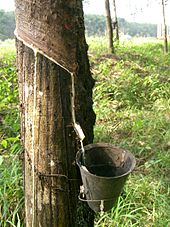Q. Describing the distribution of rubber producing countries, indicate the major environmental issues faced by them.
Ans: Rubber is primarily produced in tropical and subtropical regions around the world, where the climate and conditions are suitable for rubber tree cultivation. The major rubber-producing countries are primarily located in Southeast Asia, Africa, and South America.

Here’s a brief overview of the distribution of rubber-producing countries and the major environmental issues they face:
Distribution of Rubber-Producing Countries:
- Southeast Asia:
- Southeast Asian countries dominate global rubber production. The region’s hot and humid climate provides optimal conditions for rubber cultivation.
- Major rubber-producing countries in Southeast Asia include Thailand, Indonesia, Vietnam, Malaysia, and Cambodia.
- Africa:
- Several African countries are significant rubber producers, particularly in West and Central Africa.
- Major rubber-producing countries in Africa include Nigeria, Ivory Coast, Liberia, and Cameroon.
- South America:
- South American countries also contribute to global rubber production, with Brazil being a notable producer.
- Other rubber-producing countries in South America include Colombia and Ecuador.
Major Environmental Issues Faced by Rubber-Producing Countries:
- Deforestation: Rubber plantations often lead to deforestation as forests are cleared to make way for rubber trees. This can result in loss of biodiversity, disruption of ecosystems, and increased carbon emissions.
- Biodiversity Loss: The conversion of natural habitats to rubber plantations can lead to habitat loss and degradation, negatively impacting native flora and fauna. Monoculture plantations also reduce biodiversity.
- Water Management: Rubber cultivation requires substantial water resources, and poor water management practices can lead to over-extraction of water from local water bodies, affecting aquatic ecosystems and water availability for other uses.
- Chemical Use: Pesticides and fertilizers are often used in rubber cultivation, which can lead to soil and water pollution, harm to non-target species, and health risks for workers and local communities.
- Soil Degradation: Intensive rubber cultivation can lead to soil erosion, nutrient depletion, and reduced soil fertility, impacting long-term agricultural productivity.
- Air and Water Pollution: Processing rubber involves chemicals and effluents that can contribute to air and water pollution if not properly managed, affecting local air quality and aquatic environments.
- Climate Change: Deforestation, land use changes, and the carbon footprint associated with rubber production contribute to climate change, exacerbating environmental challenges globally.
- Social Impacts: Rubber plantations can sometimes lead to social issues, including land disputes, displacement of local communities, and poor labor conditions.
Efforts are being made to address these environmental issues through sustainable rubber production practices, agroforestry approaches, certification programs, and improved land management. The rubber industry and governments in rubber-producing countries are increasingly recognizing the importance of sustainable practices to mitigate environmental impacts and ensure the long-term viability of rubber production.